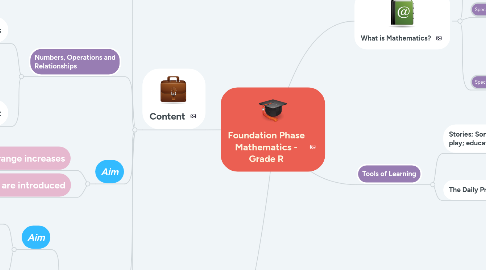
1. Content
1.1. Geometry
1.1.1. Aim
1.1.1.1. Focusing on new properties and features of shapes and objects in the grade
1.1.1.2. Movig from learning the language of position and matching different viewsof the same objectsto reading and following instructions on aan informal map
1.1.2. Position, orientation and views
1.1.2.1. Language of Position
1.1.2.1.1. e.g. Describe the position of one object in relation to another; left; right; up; down
1.1.2.2. Position and Direction
1.1.2.2.1. e.g Follow directions to move around the classroom
1.2. Numbers, Operations and Relationships
1.2.1. Context-Free Calculations
1.2.1.1. Mental Mathematics
1.2.1.1.1. e.g. Counting Forwards and Backwards
1.2.1.1.2. e.g. Ordinal Counting
1.2.1.1.3. e.g. Counting Everyday Objects
1.2.1.2. Addition and Subtraction
1.2.1.2.1. e.g. Gain the ability to solve verbally stated problems with solutions up to 10
1.2.2. Number Concept Development
1.2.2.1. Number Symbols and Number Names
1.2.2.1.1. e.g Recognize, Identify and Read number symbols 1 to 10
1.2.2.1.2. e.g. Recognize, Identify and Read number names up to 10
1.3. Aim
1.3.1. The number range increases
1.3.2. Different kinds of numbers are introduced
1.4. Measurement
1.4.1. Aim
1.4.1.1. New forms of measuring
1.4.1.2. New measuring tools' starting with informal and moving to formal measuring instruments
1.4.2. Time
1.4.2.1. Passing of Time
1.4.2.1.1. Order regular events from their ownlives
1.4.2.1.2. Talk about things that happen during the day and night
1.4.2.1.3. Learners sequence events that happen to them during the day
1.5. Patterns, Functions and Algebra
1.5.1. Geometric Patterns
1.5.1.1. Copy and extend simple patterns using physical objects and drawings
1.5.1.1.1. e.g. Using colors and shapes
1.5.2. Aim
1.5.2.1. Complete and extend patterns represented in different forms
1.5.2.2. Identify and Describe different patterns
2. Resources
2.1. A set of flash cards
2.2. A large analogue wall clock
2.3. Counters
2.4. Large Dice
2.5. A height chart
3. What is Mathematics?
3.1. Definition
3.1.1. "Mathematics is a language that makes use of symbols and notations for describing numerical, geometric and graphical relationships."
3.2. Specific Aims
3.2.1. "Critical awareness of how mathematical relationships are used in social, environmental, cultural and economic relations.
3.2.1.1. "The application of mathematics to physical, social and mathematical problems.'
3.2.1.2. "The study of related subject matter and further study in mathematics."
3.3. Specific Skills
3.3.1. "Develop the correct use of the language of mathematics"
3.3.1.1. "Learn to listen, communicate, think, reason logically and apply the mathematical knowledge gained"
3.3.2. "Learn to pose and solve problems"
3.3.2.1. "Learn to investigate, analyze, represent and interpret information"
4. Tools of Learning
4.1. Stories; Songs; rhymes; finger games; water play; educational toys and board games
4.2. The Daily Programme
4.2.1. Teacher-guided activities
4.2.2. Routines
4.2.3. Child-initiated activities/Free Play
